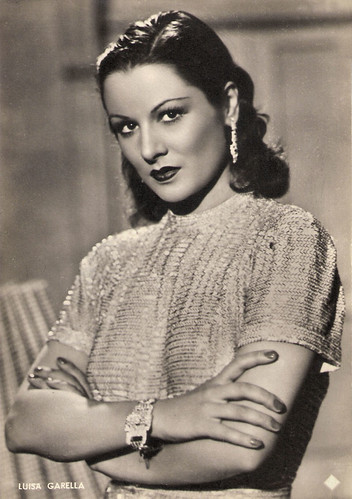
Italian postcard by Aser, no. 151. Photo: Luxardo Scia Film.
Getting stuck in the sand
Luisa Garella was born as Luisa Gargarella in Firenze (Florence) in 1913, according to Les gens du Cinema. Wikipedia mentions 1921 as her birth year.
She made her film debut in a minor role in Paraninfo/The Matchmaker (Amleto Palermi, 1934). In 1936 she played the girlfriend of George Rigaud in the French-Italian drama L'esclave blanc/Black Jungle (Jean-Paul Paulin, 1936).
DB DuMonteil at IMDb: "L'Esclave Blanc was recently brought out of oblivion, thanks to a DVD release, with English subtitles. First intended for Carl Theodore Dreyer, who used to talk about the white man, ‘getting stuck in the sand’ in a country which was not his.
Jean-Paul Paulin's work is very obscure, even for French viewers: when he replaced Dreyer, he had already made three movies, two of which are still screened on TV: La Femme Nue and the rather funny comedy l'Abbé Constantin. He called it a day in 1950, 26 years before he died. To write that L'Esclave Blanc is a colonialist movie is to state the obvious: the last pictures show a peaceful land, under the white man's watchful eye.”
The following year, Luisa Garella played Hedwig in the comedy L'uomo che sorride/The Man Who Smiles (Mario Mattioli, 1937) opposite Vittorio De Sica and Assia Noris.

Italian postcard.
The woman in black
In 1941 Luisa Garella played Franca in a version of the comedy Scampolo (Nunzio Malasomma, 1941) with Amedeo Nazzari and Lilia Silvi in the title role.
Another film in which she played a supporting role was the thriller Grattacieli/Skyscrapers (Guglielmo Giannini, 1943) in the role of Helga Manners. Again under the direction of Giannini, she played Carla Rossiter in 4 ragazze sognano/4 Girls Dream (Guglielmo Giannini, 1943) co-starring with Vanna Vanni and Valentina Cortese.
That same year, she also appeared in the film La signora in nero/The Woman in Black (Nunzio Malasomma, 1943), in the role of Rosetta May. Because of the war, the film was released somewhat haphazardly. It was briefly shown in December 1943 in Rome, but the Italian public had to wait until 1945 to see it. It eventually went on general release in June 1946.
After this brief film career, Luisa Garella abandoned the cinema. There needs to be more information about her later years. IMDb mentions one post-war credit: a small part in an American TV series, Conrad Nagel Theater (1955).
Luisa Garella passed away in Italy, in 1983 in Rome. She was 70.

Italian postcard by Rizzoli & C., Milano, 1942. Photo: Luxardo.
Sources: Associazione Culturale "CINEMA ITALIANO DEGLI ANNI D'ORO" (Italian - Facebook), Les gens du Cinema (French), Wikipedia (Italian and English), and IMDb.
This post was last updated on 7 April 2024. With thanks to Heimer.
There's an update in her English wiki regarding her death. This is the source
ReplyDeletehttps://www.facebook.com/groups/379611182665828/posts/1354180388542231/
Thanks, Heimer. Much appreciated. We've updated the post.
ReplyDelete